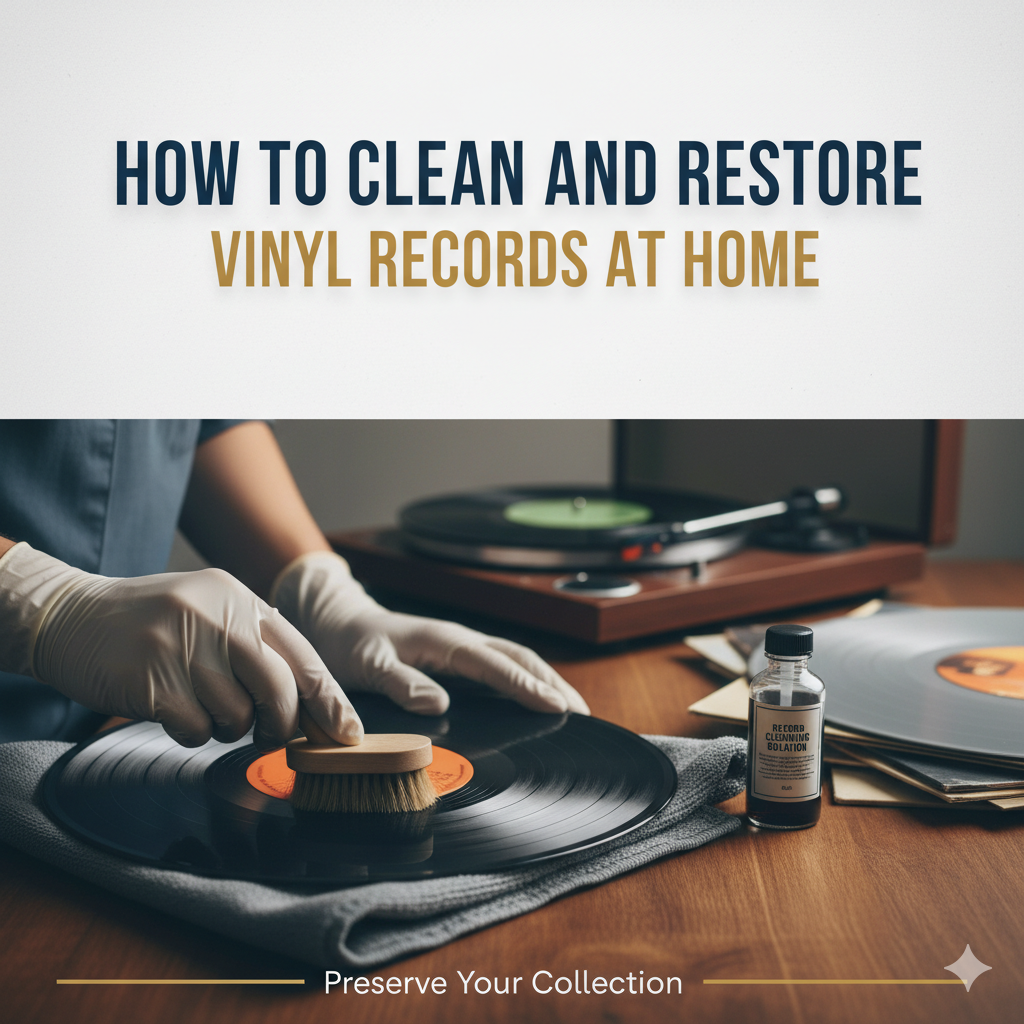How to clean and restore vinyl records at home — a practical, safe step-by-step guide
If you’ve found a stack of dusty LPs in the attic and want to know how to clean and restore vinyl records at home, you’re in the right place. This guide breaks the process into safe, DIY steps so you can remove surface dust, lift embedded grime, and restore playable life to your collection — all without expensive machines. Spin-Clean® Record Washers+1
Learning how to clean and restore vinyl records at home isn’t just about aesthetics — clean grooves reduce pops, clicks and stylus wear. You’ll learn quick everyday routines (brush before play), deeper wet-cleaning recipes, and one-time deep-restoration tricks that hobbyists use. TurntableLab.com+1
Follow these steps and you’ll feel confident tackling everything from lightly dusty singles to records with moderate mildew or sticky residues. This article covers safe solutions, tools to avoid, and what to do for stubborn grime — so you can restore records without damaging them. Pro-Ject Audio USA
What you’ll need (basic kit)
-
Carbon-fiber or anti-static record brush (for before/after playing). Spin-Clean® Record Washers
-
Microfiber cloths (lint-free).
-
Distilled water (do not rely on tap water). Pro-Ject Audio USA
-
Mild dish soap (few drops) or a dedicated record cleaning fluid. House of Marley
-
Isopropyl alcohol only in low concentration formulas or for moldy records (see warnings). House of Marley+1
-
Optional: a Spin-Clean or manual record washer for batch cleaning. Reddit+1
Quick routine cleaning (under 2 minutes per side)
-
Hold the record by the rim and label.
-
Use a carbon-fiber brush to remove loose dust: set brush on spinning record and slowly rotate it a few turns; brush from outer edge toward label. This reduces static and airborne dust before playing. Spin-Clean® Record Washers+1
-
If smudges remain, lightly mist a microfiber cloth with distilled water (or a safe record spray) and wipe along the grooves — always move in the direction of the grooves (circular, not radially). Pro-Ject Audio USA
Deep cleaning — safe DIY wet method (for dirty records)
This method is excellent for surface grime and light residues.
Recipe (gentle):
-
3 parts distilled water
-
1/4 part isopropyl alcohol (optional, low %) OR a few drops of mild dish soap
-
Optional: a tiny drop of rinse aid (some hobbyists use it to reduce spotting)
Steps:
-
Place record on a clean flat surface supported by a soft towel.
-
Apply solution sparingly with a soft brush or spray bottle — avoid the paper label (don’t soak labels). House of Marley+1
-
Gently brush with a soft, soft-bristled brush following groove direction.
-
Rinse with distilled water (lightly) and pat dry with microfiber, then air-dry vertically in a clean sleeve.
Notes & safety: Many pros advise against frequent use of high concentration isopropyl alcohol; it can, over time, affect certain vinyl finishes. Use distilled water + mild soap when possible. Pro-Ject Audio USA+1
Deep restoration — wood-glue method (for extreme grime)
For collectors restoring very dirty or gummy records, the wood-glue (polyvinyl acetate) peel method can remove deep embedded dirt and sundry residues. Apply a thin, even layer of PVA wood glue over the playing surface (not the label), let it fully dry, then peel it off — the glue lifts contaminants from grooves. This is aggressive but often effective; test it on a sacrificial disc first and follow community guides. Every record tells a story
Caution: Do not use glue on rare or extremely valuable pressings unless you accept the risk; practice on cheap records first.
Mold, mildew, and sticky residues
Moldy records require care: remove loose spores outdoors, then clean with a slightly stronger solution (some recommend 1 part isopropyl to 3 parts water) applied with care, wiping in groove direction. For heavy mold, professional remediation may be safest. Avoid steam cleaners — they can spread spores and damage vinyl. Always wear gloves and work in a ventilated area when treating mold. polygongroup.com+1
Tools & machines: is it worth buying a record cleaning machine?
Hand cleaning works well for most collectors, but ultrasonic or vacuum record cleaners (e.g., VPI, Spin-Clean) are faster and often cleaner for large collections or very dirty records. Many hobbyists pair routine brushing with occasional machine cleaning for the best results. Reddit+1
What NOT to do
-
Don’t use tap water (minerals leave deposits). Pro-Ject Audio USA
-
Don’t scrub labels wet or saturate them.
-
Avoid harsh solvents (acetone, strong degreasers) — they can ruin vinyl.
-
Don’t use abrasive pads or rough brushes that can create micro-scratches.
Extra tips for long life
-
Store vertically in anti-static inner sleeves and sturdy outer covers.
-
Keep humidity moderate and avoid hot, damp storage (mold risk). Southern Living
-
Clean stylus regularly; a clean stylus reduces groove damage and noise.
FAQs
Q: Can I use regular rubbing alcohol to clean records?
A: Use low concentration isopropyl only sparingly and diluted. Many experts recommend distilled water + mild soap as the safest routine solution. House of Marley+1
Q: Will a carbon fiber brush damage my records?
A: No — when used gently and only for dust removal, carbon fiber brushes are widely recommended to remove static and loose dust before play. Spin-Clean® Record Washers
Q: How often should I deep-clean my records?
A: For regular use, deep clean every few months or when you notice increased pops and background noise. Routine brushing before each play reduces the need for frequent wet cleaning.
Conclusion
If you want to know how to clean and restore vinyl records at home, start with a carbon-fiber brush and distilled-water wipes for everyday care, then move to gentle wet cleaning for dirtier discs. For stubborn buildup consider targeted methods like the wood-glue peel or a dedicated record washer — but always test and proceed cautiously. By following safe recipes and storing records carefully you’ll keep them sounding great for years. Remember: how to clean and restore vinyl records at home starts with gentle, groove-friendly motions, and ends with good storage and a happy stylus. If you ever tackle extreme mold or an irreplaceable pressing, consider professional help — but these steps will get most collections back into play. how to clean and restore vinyl records at home — you can do it, and your records will thank you. Pro-Ject Audio USA+2

